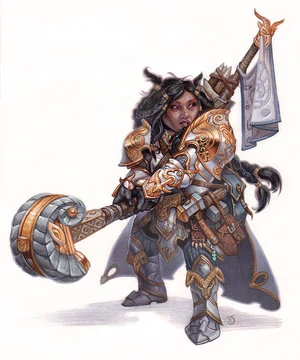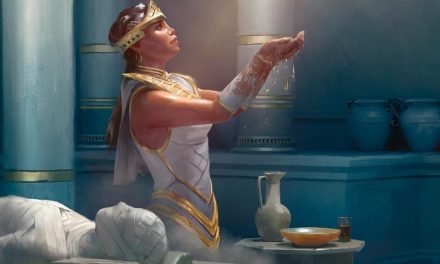The Forge Cleric in D&D 5e taps into a divine idea at the very core of civilization. After all, the idea of gods of craftsmanship is just as present in the real world as it is in fantasy worlds!
In many ways, these deities offer the most tangible symbols of their influence. Entire cities, societies, and cultures have been built on the expert designs and craftsmanship of artisans.
Consider real-world ancient wonders of engineering and construction such as the Pyramids, the Roman Colosseum, or Machu Picchu!
In both designing and creating things of any size for any purpose, there’s no substitute for true craftsmanship and excellence!
This is the principle that guides Forge Clerics!
Do you have the resolve, commitment, and eye for detail necessary to become a master of your chosen craft?
This is the full subclass guide to the Forge Cleric in D&D 5e!
What is the Forge Cleric in D&D 5e?
Forge Clerics know that there is a great deal of potential within anyone and anything. It just requires hard work, patience, and craftsmanship refined over many years to fully realize such potential.
However, one’s own resilience is also necessary for such a process to happen. After all, the strongest steels are forged in the hottest fires!
Combining all these traits with an undeniable eye for detail and commitment to excellence makes for a very powerful combatant.
If anyone is going to have the most optimized armor and weaponry in the party, it’s almost certainly going to be the Forge Cleric!
Popular deities for Forge Clerics include:
- Moradin, Dwarven God of Creation
- Helm, God of Protection
- Lathander, God of Creativity and Self-Perfection
- Hephaestus, Ancient Greek God of Fire and Craftsmanship
The Forge Cleric is found in Xanathar’s Guide to Everything alongside the Grave Cleric subclass option.
Role in the Party
The Forge Cleric is firmly meant to stand on the front lines of their party.
Decked out in heavy armor (that they no doubt crafted and maintain themselves), these Clerics focus heavily on protecting those around them and bringing the heat upon their enemies.
But even outside of combat, Forge Clerics contribute a great deal of utility to their party.
Between their spells and features, there’s virtually no problem that Forge Clerics can’t engineer a solution to. Even when they need to work on the fly, these characters’ abilities as expert craftspeople can help the party completely avoid otherwise perilous situations or encounters!
Putting this all together, you get a type of character that can be virtually unstoppable.
With an armor class that’s nothing short of disgusting, high damage output, and remarkably engineering abilities, there’s seemingly nothing a Forge Cleric can’t do!

Forge Cleric Features 5e
The Forge Cleric covers a wide range of capabilities within their party and is remarkable at all of it!
You’ll get an excellent spell list as a Forge Cleric that will serve you very well.
Meanwhile, your subclass features really ramp up your ability to empower yourself and your allies while bringing the hammer down on your foes. Not to mention your very open-ended utility features with seemingly limitless applications!
Let’s fire up the forge and look over the Forge Cleric’s features!
Also Check Out: Using Turn and Destroy Undead in D&D 5e!
Forge Domain Spells
Every Divine Domain (Cleric subclass) also comes with its own unique list of bonus spells. These are called Domain Spells.
You gain these Domain Spells when you hit the level on the table below. These spells are considered to always be prepared for you and they don’t count against the number of spells you can prepare each day.
Some Domain Spell lists might include spells that aren’t normally on the Cleric spell list. In these cases, the spell counts as a Cleric spell for you and uses your Wisdom modifier as the spellcasting ability.
So, let’s check out what you get for choosing the Forge Domain!
| Cleric Level | Domain Spells |
| 1 | Identify, Searing Smite |
| 3 | Heat Metal, Magic Weapon |
| 5 | Elemental Weapon, Protection From Energy |
| 7 | Fabricate, Wall of Fire |
| 9 | Animate Objects, Creation |
To really bring more with the Forge Cleric’s theme and role, it’s probably a wise idea to also pick up the Mending cantrip as well!
Thoughts on the Forge Cleric Spell List
The Forge Cleric’s spell list gives you a ton of options that you typically wouldn’t have access to. All in all, this list gives you a nice boost to your offensive ability as well as your overall utility.
Searing Smite is the star of your spell list. You’ll be getting great use out of this at every level!
Meanwhile, it’s nice to have Identify handy so you don’t need to take a long rest to prepare the spell and identify that sweet loot you just picked up.
I have to admit, Heat Metal is one of my favorite spells in the game. When it’s effective (especially against enemies in armor), it’s nearly broken.
Magic Weapon is somewhat redundant with your Channel Divinity option (Blessing of the Forge), but it’s still useful to have so you can buff two allies’ gear!
Having Protection from Energy is incredibly helpful, especially if you’re going up against an enemy that favors a specific damage type. If an enemy has a weakness to certain elements, Elemental Weapon can be incredibly useful.
Wall of Fire is a fantastic spell that can deal great damage and effectively zone enemies. Used strategically, it can have a huge impact on any combat.
With the proper materials and some creativity, Fabricate can get you out of nearly any situation.
In fact, both spells you gain at level 9, Animate Objects and Creation, work this way too. Fitting with a class that reveres craftsmanship and ingenuity, the main limit to these spells is your own creativity!

Bonus Proficiencies (Level 1)
We’re starting things off with some bonus proficiencies!
You gain proficiency with heavy armor and smith’s tools.
Forge Clerics are at their best when they’re on the front line. Out of combat, they’re clever and talented craftspeople with a knack for engineering their way around problems.
Because Forge Clerics can wear Heavy Armor, this makes for a great boost to your Armor Class.
Since you’re already also focusing on abilities like Wisdom (for spellcasting), Constitution (for survivability), and Strength (for melee attacks/damage), this also removes the need for you to also focus on investing in your Dexterity.
Smith’s Tools are a no-brainer for a subclass that’s all about making things.
Blessing of the Forge (Level 1)
A +1 bonus might not sound like much, but it absolutely is.
Especially if your game tends to be a little lighter on magic items, this is a truly exceptional feature. You should plan to end every long rest by using this on either your own or an ally’s gear.
At the end of a long rest, you can touch one nonmagical object which is a suit of armor or a simple or martial weapon.
Until the end of your next long rest or until you die, the object becomes a magic item, granting a +1 bonus to AC if it’s armor or a +1 bonus to attack and damage rolls if it’s a weapon.
Once you use this feature, you can’t use it again until you finish a long rest.
This is a SUPER IMPORTANT feature to Forge Clerics, so let’s go over some of the finer points of this…
Using Blessing of the Forge
There are tons of creatures like werewolves or specters that resist damage from nonmagical weapons. In the early game, this can make them both infuriating and deadly to fight. Because you’re making a weapon magical with this feature, it can overcome that resistance!
Not to mention, a +1 bonus is all it takes to turn a hit into a miss or successfully drop an enemy!
It’s important to note that you cannot stack Blessing of the Forge. So even if your group has two Forge Clerics, the item that receives this blessing is then considered magical and cannot be blessed again.
However, Blessing of the Forge DOES STACK with your Soul of the Forge feature at level 6!
Beyond that, it’s up to you how you apply Blessing of the Forge. If you tend to lead the party’s charge in combat, it’s probably better used on you. Otherwise, it can be a great way of supporting another party member’s damage output or defenses.
And don’t forget that Blessing of the Forge is not a permanent buff. To keep the bonus on a specific weapon or armor, you’ll need to reapply it after each long rest.
While this can make it effectively permanent, you’re still free to reapply the blessing as needed!
Additionally, Blessing of the Forge is not able to be used on Shields. Since the specific wording of the feature is “a suit of armor or a simple or martial weapon” you won’t be able to create an über-shield for yourself or your ally.

Channel Divinity: Artisan’s Blessing (Level 2)
A true artisan brings a mixture of creativity and talent into their craft. It’s what allows them to design and craft the highest-quality goods that meet their intended purpose.
As a Forge Cleric, you are most certainly a true artisan!
You conduct an hour-long ritual that crafts a nonmagical item that must include some metal. Options include a simple or martial weapon, a suit of armor, ten pieces of ammunition, a set of tools, or another metal object from the Player’s Handbook.
The creation is completed at the end of the hour, appearing in an unoccupied space of your choice on a surface within 5 feet of you.
The item can be worth no more than 100gp.
As part of this ritual, you must lay out metal (which can include coins) with a value equal to the creation. The metal irretrievably transforms into the creation at the ritual’s end, magically forming even nonmetal parts of the creation.
This ritual can create a duplicate of a nonmagical item that contains metal (such as a key) if you possess the original during the ritual.
On one hand, this is an extremely situational use of your Channel Divinity.
However, this feature mixed with your own creativity can get you out of nearly any situation you might find yourself in. It’s very similar to the College of Creation Bard in that respect.
You will want to make sure that you always keep plenty of metal bits and bobs with you, but that’s pretty on-brand for a Forge Cleric. You never know when they’ll come in handy!
You’ll get the most value out of this if you have a DM that really lets you get inventive. Thankfully many DMs are and it can lead to some crazy and epic moments!
Related: That Time My Gnome Artificer Built a Death Star (Storytime)
Soul of the Forge (Level 6)
Your level 6 feature, Soul of the Forge, is just pure value for your Forge Cleric!
You gain resistance to fire damage.
Additionally, you gain a +1 bonus to your Armor Class while wearing heavy armor.
Fire damage is very common in D&D 5e, so halving the damage you take from fire is very nice!
But the +1 you’re getting to your Armor Class while in heavy armor is huge. Remember, +1 is NOT a small buff.
Let’s say you’re wearing Plate Armor.
That’s giving you an AC of 18 plus the extra bonus from Soul of the Forge which puts you at 19 AC. Using your Blessing of the Forge on your armor, you’re now at a 20 AC. If you decide to grab a shield, you’re now a TANK at level 6 with an Armor Class of 22!
Mix in a magic item or two that boosts your AC even further (like a Ring of Protection) and you become every DM’s nightmare.

Divine Strike (Level 8)
As with other Cleric subclasses, you get a handy buff when you hit level 8. As a fiery frontliner, this will let you turn up the heat in combat!
Once on each of your turns when you hit a creature with a weapon attack, you can cause that attack to deal 1d8 extra fire damage to the target.
This fire damage increases to 2d8 when you reach level 14.
I’ll never bash bonus damage, but there is a slight problem with this feature that you need to be aware of.
Fire is one of the most commonly resisted types of damage in D&D 5e. This can turn an otherwise solid feature like Divine Strike into something underwhelming.
As we’ll talk about later in this guide, you’ve hopefully taken the Elemental Adept feat to greatly improve your use of Searing Smite.
Rules as Written, this won’t improve your Divine Strike though.
As a DM, I’d be inclined to bend the rules here and let Elemental Adept also work with the Forge Cleric’s Divine Strike. I don’t think it’s an unbalanced call at all, to be honest.
I mean, you’re taking a feat to make your version of Divine Strike as reliable as other subclasses that deal rarely resisted damage, like radiant for example.
But that’s just me…
Still, you might be able to make the case and get your DM’s approval for this.
Saint of Forge and Fire (Level 17)
At level 17 you achieve sainthood with a capstone feature that is both simple and terrifyingly effective!
You gain immunity to fire damage.
While wearing heavy armor, you have resistance to bludgeoning, piercing, and slashing damage from nonmagical attacks.
So, in addition to being able to just bathe in lava, you become even more of a tank!
Your Armor Class at this point is probably maddeningly high. Now, even if something is able to get past your defenses with a melee attack, you’re only taking half damage.
Well, unless it’s a magical attack but those are still somewhat uncommon even at this level in most campaigns.
Imagine the look on an enemy’s face when you emerge from hot lava in glowing red armor and start charging at them. I don’t know about you, but I’d be terrified if I saw that coming my way!
This is an incredible capstone feature to an already incredible subclass!

Connections
Most Clerics are unsurprisingly very heavily tied to the temples in which they operate. That tends to be the vehicle by which they connect to the party and overall story.
You can certainly do that with a Forge Cleric, but the unique theme of this class also opens up some interesting character ideas.
To some, the very act of creation is in itself a way of worshipping the gods. Instead of singing hymns, these Clerics dedicate themselves fully to perfecting their ability to design and craft things.
Whether it’s something practical like high-quality farming equipment, weapons, and armor or more expressive, such craftsmanship often speaks for itself.
By the very nature of their work, Forge Clerics have a gift of vision. They can look at raw materials and vividly see the potential that lies within them. People are no different and the Forge Cleric might view their work as a way of refining and crafting a better version of themselves or those around them.
Rare or precious materials are particularly attractive to Forge Clerics. Situations involving mines or supplies of such materials will quickly earn these Clerics’ personal attention.
If the adventure hook lies elsewhere, it’s not difficult to tie a Forge Cleric into the story.
In doing their duty, they can certainly join the party for the sake of keeping everyone’s equipment in top shape to make sure everyone gets back home alive!
If the party also includes an artificer, Creation Bard, or some other such “crafty” character, there’s a huge opportunity for a strong friendship and some very memorable shenanigans!
Is the Forge Cleric Good?
Even among so many subclass options for Clerics, the Forge Cleric stands taller than most others!
The Forge Cleric makes for an incredible frontline combatant. Right from the start, they’re incredibly durable with tons of ways to boost their own combat performance and that of their allies.
Mix in the ability to creatively engineer their way out of (or into) virtually any situation and you’ve got a subclass that’s an unstoppable force of nature!
The biggest weakness of the Forge Cleric is its reliance on fire damage. As I mentioned earlier, this is a very commonly resisted type of damage.
I would recommend picking up the Elemental Adept feat early on to maximize the effectiveness of your Searing Strike. As I also mentioned previously, it’s probably worth seeing if your DM will fudge the rules a little bit to let that feat also help your Divine Strike.
But even if that’s a no-go, the Forge Cleric is incredibly powerful.
Especially if you tend to be good at finding creative solutions to practical problems, you’ll have a blast playing a Forge Cleric!
Want More? Check out my ranking of every Cleric subclass in D&D 5e!
Conclusion – Forge Cleric in D&D 5e
I hope you’ve found this guide to the Forge Cleric in D&D 5e helpful!
Admittedly, I had ended up sleeping on this Divine Domain when it was first released. For whatever reason, it just didn’t really “grab” me at first.
Until one of the players at our table made one, anyway. We were all just blown away at how crazy powerful this subclass is. She was virtually unstoppable!
But what are your thoughts on the Forge Cleric subclass? Let’s chat in the comments!
Want all the latest player guides, DM tips, news, reviews, and more for D&D 5e? Sign up for the Tabletop Joab newsletter below!
You can also follow me on Facebook and Twitter.
If you found this article helpful and want to support the site, you can buy me a coffee here! (It’s not expected, but very appreciated!)









